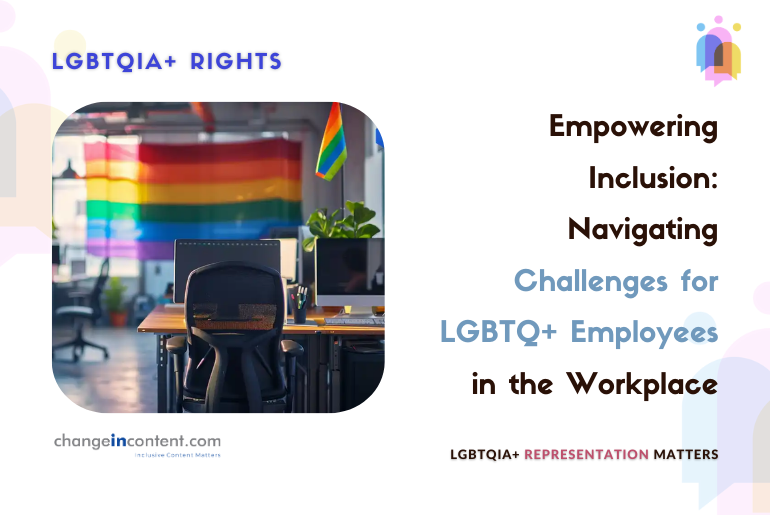Despite strides towards inclusivity, the LGBTQ+ community continues to face significant challenges in the workplace. The recent McKinsey research strongly reflects it. These challenges around LGBTQ+ workplace inclusion underscore the ongoing need for organisations to enhance support. Moreover, organisations must foster a more inclusive environment for their LGBTQ+ employees.
LGBTQ+ workplace inclusion: The challenges
Feeling like an ‘Only’
Many LGBTQ+ employees report feeling isolated in their workplaces, often being the sole representative of their sexual orientation or gender identity. McKinsey’s research reveals that over half of gay, lesbian, and nonbinary employees perceive themselves as ‘only’ in their workplace environments. This sense of isolation can inhibit their ability to express themselves and contribute effectively fully.
Microaggressions and intersectionality
Microaggressions, such as being interrupted or subjected to demeaning comments, are unfortunately common experiences for LGBTQ+ employees. The impact of these microaggressions varies within the community, with transgender individuals and LGBTQ+ women often facing heightened levels of discrimination. Addressing these subtle but harmful behaviours is crucial for creating a more respectful and inclusive workplace culture.
Challenges of Hybrid Work
While hybrid work models offer flexibility, they also present unique challenges for LGBTQ+ employees. According to McKinsey, LGBTQ+ workers are more likely than their heterosexual counterparts to feel excluded from essential developments and less connected in hybrid work settings. This disconnect can hinder their visibility and opportunities for career advancement.
Mental health and well-being
Mental health remains a sensitive issue for LGBTQ+ employees, exacerbated by a reluctance to discuss these concerns openly in the workplace. McKinsey’s findings indicate that a significant percentage of LGBTQ+ employees, especially transgender individuals, feel uncomfortable sharing their mental health issues with coworkers. It highlights the need for supportive workplace policies and cultures that prioritise mental well-being for all employees.
Inclusion gaps
Despite organisational efforts, LGBTQ+ employees report lower levels of inclusion compared to their straight counterparts. Bisexual and nonbinary individuals, in particular, experience even more significant challenges in feeling included and connected within their workplace communities. Critical areas for improvement include enhancing self-expression, improving resource accessibility, and strengthening protective mechanisms against discrimination.
Strategies for an enhanced LGBTQ+ workplace inclusion
The role of allies
Effective allyship is crucial in driving meaningful change and creating a more inclusive workplace environment. LGBTQ+ employees are more likely to engage in allyship activities and advocate for diversity, equity, and inclusion (DEI) initiatives. However, there remains a gap between LGBTQ+ employees’ active allyship and that of their straight colleagues, emphasising the importance of broader organisational support and education on allyship practices.
Advocacy and policy
Beyond organisational efforts, advocacy and policy play a crucial role in advancing LGBTQ+ rights and protections in the workplace. Legislative and policy frameworks that safeguard against discrimination based on sexual orientation and gender identity are essential for creating a supportive and inclusive environment. Organisations can contribute to these efforts by actively supporting and advocating for inclusive policies at local, national, and global levels.
Educational initiatives for LGBTQ+ workplace inclusion
Education and awareness-building initiatives are pivotal in fostering a more inclusive workplace culture. Providing training on LGBTQ+ issues, unconscious bias, and inclusive language can help mitigate stereotypes and promote respectful interactions among employees. Moreover, creating safe spaces for open dialogue and learning can empower employees to challenge biases and foster a sense of belonging for LGBTQ+ individuals.
Intersectional challenges in workplace inclusion
Intersectionality considers how various aspects of identity intersect and influence experiences of discrimination. Intersectionality is a critical factor in understanding the diverse challenges faced by LGBTQ+ individuals. Factors such as race, ethnicity, disability, and socioeconomic status intersect with sexual orientation and gender identity. These shape unique experiences of discrimination and marginalisation.
Organisations must adopt intersectional approaches to DEI initiatives to ensure that all dimensions of diversity are acknowledged and addressed.
The final thoughts on LGBTQ+ workplace inclusion
The journey towards LGBTQ+ workplace inclusion involves addressing systemic challenges and fostering a culture where all employees feel respected, valued, and empowered to bring their authentic selves to work. Organisations must prioritise creating policies, training programs, and support systems that actively promote inclusivity and equity.
By embracing diversity in its fullest sense and championing meaningful allyship, organisations can cultivate environments where LGBTQ+ employees thrive and contribute to their fullest potential. This commitment not only enhances organisational success but also fosters a more just and equitable society at large. As we move forward, continued research, advocacy, and collaborative efforts are essential in advancing LGBTQ+ workplace inclusion and creating workplaces where everyone can thrive.
Disclaimer: The views expressed in this article are based on the writer’s insights, supported by data and resources available both online and offline, as applicable. Changeincontent.com is committed to promoting inclusivity across all forms of content, which we define broadly to include media, policies, law, and history—encompassing all elements that influence the lives of women and gender-queer individuals. Our goal is to promote understanding and advocate for comprehensive inclusivity.


